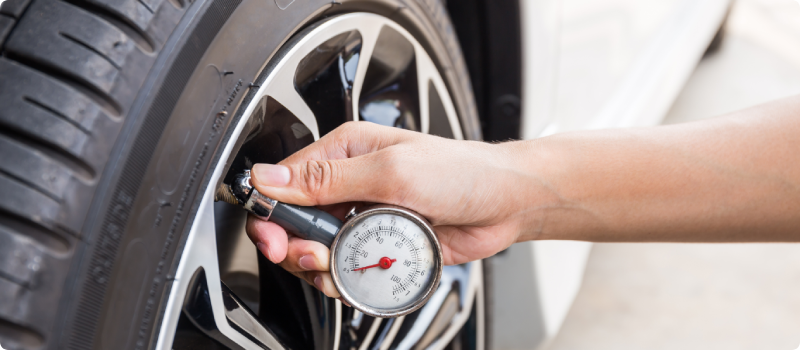What to do when you have a flat tire
Updated June 28, 2024 . AmFam Team
Updated June 28, 2024 . AmFam Team
A flat tire can be a huge bummer when out on the open road. But don’t fret! If you’re wondering what to do when you have a flat tire, we’ve got the tips and guidance you’ll need, and everything you should have on-hand when it’s time to make a repair.
So, let’s talk about how to fix a flat tire.
When it comes to your tires, being prepared is essential. Unless you have quick, easy access to emergency roadside assistance, you’ll likely be changing tires yourself.
A checklist of the following tools should be a priority to keep in case you get a flat tire:
The good news is you may have most of these tools already in your car. Many new cars come equipped with a spare tire, car jack and lug wrench. Check your vehicle’s owner’s manual to see if your car has these tools and where they are located.

Replacing a flat tire may seem challenging and time-consuming if you’ve never done it before. The truth is, by following a guide like this you’ll be a pro in no time. Here are the key steps to follow so you can fix a flat tire safely and get back on the road.
1. After you realize that your tire is flat, make sure your car is in a safe position by driving to a flat surface and away from traffic. If it’s not, call an expert or roadside assistance — they’re always ready to help.
2. Put your car in park, turn on your hazard lights and set your parking brake. If you’re not in a flat area, block your tires with your wheel wedges or other bracing material like a rock or chunk of wood to keep it from rolling.
3. Take out your spare and lug wrench. These tire-changing tools are typically located in your trunk, under your car, on the rear door or in storage cubbies on the sides of your trunk.
4. Loosen the lug nuts on the flat tire by turning the wrench counterclockwise — they’re probably on very tight, so get ready to use your full body weight or foot if needed!
5. Raise the car by placing the jack under the metal frame of your car, just behind the front tire or in front of the rear tire — depending on which one is flat.
6. Remove the lug nuts. Be sure to keep them together so they’re easy to find later!
7. Pull off the flat tire and replace it with your spare.
8. Using your hand, put the lug nuts back on as tightly as you can, twisting them clockwise.
9. Lower the jack until the tire touches the ground.
10. Using the wrench, finish tightening the lug nuts, then lower the jack completely and remove it.
11. Finally, put your tools and flat tire back in the car and head to a service station as soon as you can to repair your flat tire.
At this point, it’s a good idea to visit a service station right away so a service professional can inspect your flat tire and properly repair it if possible. This will also help prevent further damage to your tire.

Whether on a road trip or your daily commute, fixing a flat tire is one the last things you want to deal with while driving. Thankfully, there are some precautions and preventative maintenance steps you can take to prevent a flat tire and keep all four of your wheels rolling longer.
A common cause of flat tires are punctures from sharp objects. These materials are usually nails, glass, bits of metal or potholes. Avoid driving over these hazards and avoid as best you can areas like constructions zones where you’d be most likely to encounter them.
Using a tire pressure gauge to check the pressure of your tires every month is a great way to stay ahead of tire troubles. The recommended tire pressure range for your car should be listed on a label inside the driver’s door or in the vehicle’s owner’s manual.
Excess weight can really wear down the treads of your tires, making them more susceptible to a puncture. That same label listing the recommended tire pressure range for your car should also indicate the maximum weight it should carry. So, think twice about loading everything in your car when moving and try not to go over that weight.
Getting your tires rotated regularly helps even the wear, leading to longer lasting tires. Try and make a habit of getting them rotated every 6,000 to 8,000 miles you drive, or about six months.
Read more on how to keep your tires in tip-top shape and check out our top car maintenance tips.
If you have a flat tire but no spare to replace it with, you have options to temporarily patch the flat and keep driving. First, consider adding a tire repair kit to your car emergency kit. Tire repair kits usually contain an air compressor to fill the tire, as well as string plugs and tire patches to close the puncture. Typically, here’s how you use these kits to repair a flat tire:
1. Locate the puncture hole in the tire
2. Clear away any debris from the puncture
3. Insert the string plug or tire patch so that it covers the puncture
4. Trim away any excess bit of plug or patch so it’s flush with the tire
5. If you have one, use the air compressor to fill the tire
6. Head to a service station to get your damaged tire checked out
Looking for more helpful tips and resources to protect your car from the unexpected? Check out our car maintenance tips for more helpful advice to ensure your car is ready for your next adventure!
This article is for informational purposes only and based on information that is widely available. We believe this information is accurate but do not make any guarantees or promise any results based on this information.